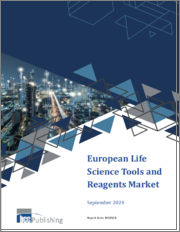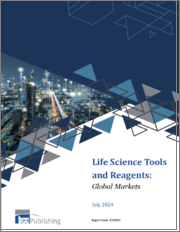
|
시장보고서
상품코드
1593461
세계의 생명 과학 툴 시장 - 규모, 점유율, 성장 분석 : 제품별, 기술별, 최종 용도별, 지역별 산업 예측(2024-2031년)Life Science Tool Market Size, Share, Growth Analysis, By Product, By Technology, By End-use, By Region - Industry Forecast 2024-2031 |
||||||
생명과학 툴 세계 시장 규모는 2022년에 1,440억 9,000만 달러로 평가되었고, 2023년 1,596억 7,000만 달러에서 2031년에는 3,629억 5,000만 달러로 성장할 것으로 예측 되며, 예측 기간 중(2024-2031년)의 CAGR은 10.81%로 전망됩니다.
생물과학을 포함한 생명과학은 인간과 동물을 포함한 생물의 이해를 깊게 하는데 있어서 매우 중요한 역할을 하고 있습니다. 기술, 유전학, 생화학 등 다양한 학문 분야를 통합하고 있습니다.에서 건강, 의학, 농업, 제약, 식품 과학에 걸친 프로세스를 촉진하는 다양한 분석 툴, 장비, 소모품, 시약을 제공합니다. 개발을 통해 인간의 건강을 개선 할뿐만 아니라 질병 메커니즘의 이해를 깊게합니다. 또한 생명 과학은 환경 문제와 생물 다양성에 대한 중요한 통찰력을 제공하고 지구를 보호하기 위한 노력을 촉진하고 있습니다. 분석 솔루션에 대한 지속적인 수요와 건강 상태 개선이라는 급무에 견인되어 다음 예측 연도에 지속 가능한 CAGR을 통해 강력한 성장을 이룰 것으로 예상됩니다. 이 시장은 의료와 자연 보호 모두의 미래를 형성하는 중요한 선수로 자리매김하고 있습니다.
목차
소개
- 조사의 목적
- 정의
- 시장 범위
조사 방법
- 정보 조달
- 2차 데이터 소스와 1차 데이터 소스
- 시장 규모 예측
- 시장의 상정과 제한
주요 요약
- 시장 개요 전망
- 공급 수요 동향 분석
- 부문별 기회 분석
시장 역학과 전망
- 시장 역학
- 성장 촉진요인
- 기회
- 억제요인
- 과제
- Porter's Five Forces 분석
주요 시장 인사이트
- 주요 성공 요인
- 경쟁도
- 주요 투자 기회
- 시장 생태계
- 밸류체인 분석
- 공급망 분석
- 특허 분석
- 무역 분석
- 기술 분석
- 규제 상황
- 가격 분석
생명 과학 툴 시장 : 제품별
- 시장 개요
- 세포 배양 시스템과 3D 세포 배양
- 액체 크로마토그래피
- 질량 분석
- 플로우 사이토메트리
- 클로닝과 유전체 공학
- 키트 시약 소모품
- 서비스
- 현미경 검사 및 전자 현미경 검사
- 차세대 시퀀싱
- PCR과 qPCR
- 핵산 준비
- 핵산 마이크로어레이
- 생어 시퀀싱
- 트랜스펙션 디바이스와 유전자 전달 기술
- 장치
- 시약
- 핵자기 공명
- 기타 분리 기술
- 기타 제품 및 서비스
- 항체
- 일반용품
- 기타
생명 과학 툴 시장 : 기술별
- 시장 개요
- 유전체 기술
- 단백질체학 기술
- 세포 생물학 기술
- 실험실용품과 기술
- 기타 분석 및 시료 준비 기술
생명 과학 툴 시장 : 용도별
- 시장 개요
- 정부와 학술기관
- 바이오의약품회사
- 헬스케어
- 산업용도
- 기타
생명 과학 툴 시장 : 지역별
- 시장 개요
- 북미
- 미국
- 캐나다
- 유럽
- 독일
- 스페인
- 프랑스
- 영국
- 이탈리아
- 기타 유럽
- 아시아태평양
- 중국
- 인도
- 일본
- 한국
- 기타 아시아태평양
- 라틴아메리카
- 브라질
- 기타 라틴아메리카
- 중동 및 아프리카(MEA)
- GCC 국가
- 남아프리카
- 기타 중동 및 아프리카
경쟁 구도
- 상위 5개사 비교
- 주요 기업의 시장 포지셔닝(2023년)
- 주요 시장 기업이 채용한 전략
- 시장에서의 최근 활동
- 주요 기업의 시장 점유율(2023년)
주요 기업 프로파일
- Agilent Technologies, Inc.
- Becton, Dickinson and Company
- F. Hoffmann-La Roche Ltd.
- Bio-Rad Laboratories, Inc.
- Danaher Corporation
- Illumina, Inc.
- Thermo Fisher Scientific, Inc.
- Qiagen NV
- Merck KGaA
- Shimadzu Corporation
- Hitachi, Ltd.
- Bruker Corporation
- Oxford Instruments plc
- Zeiss International
- Revvity Inc
- Eppendorf AG
- Sartorius AG
- Lonza Group AG
- Waters Corporation
Global Life Science Tool Market size was valued at USD 144.09 billion in 2022 and is poised to grow from USD 159.67 billion in 2023 to USD 362.95 billion by 2031, growing at a CAGR of 10.81% during the forecast period (2024-2031).
The life sciences, encompassing biological sciences, play a pivotal role in enhancing our understanding of living organisms, including humans and animals. This field, a foundational aspect of Natural Science alongside Physical Science, integrates various disciplines such as cell biology, biotechnology, genetics, and biochemistry. The life sciences tools market is expansive, offering a diverse range of analytical tools, equipment, supplies, and reagents that facilitate processes across health, medicine, agriculture, pharmaceuticals, and food science. The innovations stemming from life sciences research not only improve human health through the development of new treatments and advanced medical technologies but also enhance our comprehension of disease mechanisms. Additionally, life sciences provide critical insights into environmental issues and biodiversity, fostering efforts to protect the planet. With these contributions in mind, the US Life Science Tools Market is projected to experience robust growth at a sustainable compound annual growth rate (CAGR) in the upcoming forecast year, driven by the ongoing demand for advanced analytical solutions and the imperative for improved health outcomes. This growth trajectory underscores the importance of life sciences in addressing both health-related challenges and broader environmental considerations, positioning the market as a key player in shaping the future of both medicine and conservation.
Top-down and bottom-up approaches were used to estimate and validate the size of the Global Life Science Tool market and to estimate the size of various other dependent submarkets. The research methodology used to estimate the market size includes the following details: The key players in the market were identified through secondary research, and their market shares in the respective regions were determined through primary and secondary research. This entire procedure includes the study of the annual and financial reports of the top market players and extensive interviews for key insights from industry leaders such as CEOs, VPs, directors, and marketing executives. All percentage shares split, and breakdowns were determined using secondary sources and verified through Primary sources. All possible parameters that affect the markets covered in this research study have been accounted for, viewed in extensive detail, verified through primary research, and analyzed to get the final quantitative and qualitative data.
Global Life Science Tool Market Segmental Analysis
Global Life Science Tool Market is segmented by Product, Technology, End-use, and Region. Based on Product, the market is segmented into Cell Culture Systems & 3D Cell Culture, Liquid Chromatography, Mass Spectrometry, Flow Cytometry, Cloning & Genome Engineering (Kits, Reagents, and Consumables, Services), Microscopy & Electron Microscopy, Next Generation Sequencing, PCR & qPCR, Nucleic Acid Preparation, Nucleic Acid Microarray, Sanger Sequencing , Transfection Devices & Gene Delivery Technologies (Equipment, Reagents), NMR, Other Separation Technologies, Other Products & Services (Antibodies, General Supplies, Others). Based on Technology, the market is segmented into Genomic Technology, Proteomics Technology. Cell Biology Technology, Lab Supplies & Technologies, Other Analytical & Sample Preparation Technology. Based on End-use, the market is segmented into Government & Academic, Biopharmaceutical Company, Healthcare, Industrial Applications, Others. Based on region, the market is segmented into North America, Europe, Asia Pacific, Latin America and Middle East & Africa.
Driver of the Global Life Science Tool Market
The Global Life Science Tool market is experiencing robust growth driven by rapid technological advancements in sequencing technologies, mass spectrometry, NMR, chromatography, and other analytical methods. Increased investment in research and development by market players, coupled with a surge in strategic partnerships and innovations, significantly propels market expansion. The flurry of acquisitions within the life sciences and biopharma sectors in 2020 has set the stage for accelerated growth in subsequent years, as more companies enhance their capabilities across the biological production value chain. This evolving landscape empowers a diverse range of players, thereby significantly fueling the overall market development.
Restraints in the Global Life Science Tool Market
The Global Life Science Tool market faces significant restraints due to several factors that hinder widespread adoption and implementation. The high costs associated with life science software implementation can deter smaller institutions and research facilities from investing in necessary tools, limiting overall market growth. Additionally, the complex programming required for effective utilization presents a steep learning curve, further complicating user adoption. The necessity for additional infrastructural support and accompanying data management expenses can strain budgets, particularly for organizations with constrained resources. These combined challenges create a barrier to entry, preventing equitable access to advanced life science tools across the industry.
Market Trends of the Global Life Science Tool Market
The Global Life Science Tool market is poised for significant growth, bolstered by comparatively streamlined approval processes compared to pharmaceuticals and medical devices. This trend facilitates the rapid introduction of a diverse array of life science tools, essential for addressing the rising prevalence of infectious diseases. These instruments play a pivotal role in disease identification, comprehension, and monitoring, thus driving market demand. Furthermore, continuous technological advancements and enhancements in the production capabilities of life science tools are expected to contribute to market expansion. Collectively, these factors position the Life Science Tool market for a robust upward trajectory in the coming years.
Table of Contents
Introduction
- Objectives of the Study
- Definitions
- Market Scope
Research Methodology
- Information Procurement
- Secondary & Primary Data Sources
- Market Size Estimation
- Market Assumptions & Limitations
Executive Summary
- Market Overview Outlook
- Supply Demand Trend Analysis
- Segmental Opportunity Analysis
Market Dynamics & Outlook
- Market Dynamics
- Drivers
- Opportunities
- Restraints
- Challenges
- Porters Analysis
- Competitive rivalry
- Threat of Substitute Products
- Bargaining Power of Buyers
- Threat of New Entrants
- Bargaining Power of Suppliers
Key Market Insights
- Key Success Factor
- Degree of Competition
- Top Investment Pockets
- Ecosystem of the Market
- Value Chain Analysis
- Supply Chain Analysis
- Patent Analysis
- Trade Analysis
- Technology Analysis
- Regulatory Landscape
- Pricing Analysis
Life Science Tool Market, By Product
- Market Overview
- Cell Culture Systems & 3D Cell Culture
- Liquid Chromatography
- Mass Spectrometry
- Flow Cytometry
- Cloning & Genome Engineering
- Kits, Reagents, and Consumables
- Services
- Microscopy & Electron Microscopy
- Next Generation Sequencing
- PCR & qPCR
- Nucleic Acid Preparation
- Nucleic Acid Microarray
- Sanger Sequencing
- Transfection Devices & Gene Delivery Technologies
- Equipment
- Reagents
- NMR
- Other Separation Technologies
- Other Products & Services
- Antibodies
- General Supplies
- Others
Life Science Tool Market, By Technology
- Market Overview
- Genomic Technology
- Proteomics Technology
- Cell Biology Technology
- Lab Supplies & Technologies
- Other Analytical & Sample Preparation Technology
Life Science Tool Market, By End-use
- Market Overview
- Government & Academic
- Biopharmaceutical Company
- Healthcare
- Industrial Applications
- Others
Life Science Tool Market Size by Region
- Market Overview
- North America
- USA
- Canada
- Europe
- Germany
- Spain
- France
- UK
- Italy
- Rest of Europe
- Asia Pacific
- China
- India
- Japan
- South Korea
- Rest of Asia-Pacific
- Latin America
- Brazil
- Rest of Latin America
- Middle East & Africa (MEA)
- GCC Countries
- South Africa
- Rest of MEA
Competitive Landscape
- Top 5 Player Comparison
- Market Positioning of Key Players, 2023
- Strategies Adopted by Key Market Players
- Recent Activities in the Market
- Key Companies Market Share (%), 2023
Key Company Profiles
- Agilent Technologies, Inc.
- Company Overview
- Business Segment Overview
- Financial Updates
- Key Developments
- Becton, Dickinson and Company
- Company Overview
- Business Segment Overview
- Financial Updates
- Key Developments
- F. Hoffmann-La Roche Ltd.
- Company Overview
- Business Segment Overview
- Financial Updates
- Key Developments
- Bio-Rad Laboratories, Inc.
- Company Overview
- Business Segment Overview
- Financial Updates
- Key Developments
- Danaher Corporation
- Company Overview
- Business Segment Overview
- Financial Updates
- Key Developments
- Illumina, Inc.
- Company Overview
- Business Segment Overview
- Financial Updates
- Key Developments
- Thermo Fisher Scientific, Inc.
- Company Overview
- Business Segment Overview
- Financial Updates
- Key Developments
- Qiagen N.V.
- Company Overview
- Business Segment Overview
- Financial Updates
- Key Developments
- Merck KGaA
- Company Overview
- Business Segment Overview
- Financial Updates
- Key Developments
- Shimadzu Corporation
- Company Overview
- Business Segment Overview
- Financial Updates
- Key Developments
- Hitachi, Ltd.
- Company Overview
- Business Segment Overview
- Financial Updates
- Key Developments
- Bruker Corporation
- Company Overview
- Business Segment Overview
- Financial Updates
- Key Developments
- Oxford Instruments plc
- Company Overview
- Business Segment Overview
- Financial Updates
- Key Developments
- Zeiss International
- Company Overview
- Business Segment Overview
- Financial Updates
- Key Developments
- Revvity Inc
- Company Overview
- Business Segment Overview
- Financial Updates
- Key Developments
- Eppendorf AG
- Company Overview
- Business Segment Overview
- Financial Updates
- Key Developments
- Sartorius AG
- Company Overview
- Business Segment Overview
- Financial Updates
- Key Developments
- Lonza Group AG
- Company Overview
- Business Segment Overview
- Financial Updates
- Key Developments
- Waters Corporation
- Company Overview
- Business Segment Overview
- Financial Updates
- Key Developments


















